Global Spice Guide: Essential Spices for Every Cuisine
Spices are the foundation of global cuisine, defining flavors, cultural identity, and culinary traditions. This comprehensive guide covers essential spices for every kitchen, regional spice profiles, practical usage tips, storage advice, and expert buying recommendations to elevate your cooking.
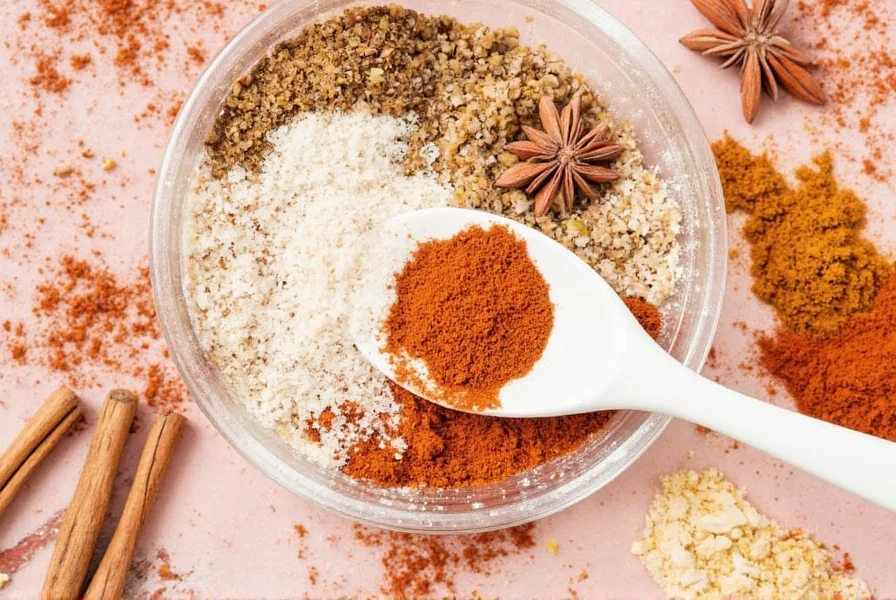
Core Spice Functions Across Cuisines
| Cuisine | Primary Spice Functions | Key Spices |
|---|---|---|
| Mexican | Heat, depth, smokiness | Ancho chili, cumin, oregano, epazote |
| Indian | Layered complexity, digestive support | Turmeric, cumin, coriander, garam masala |
| Thai | Balanced heat, citrus, herbal freshness | Lemongrass, galangal, kaffir lime, Thai chilies |
| Middle Eastern | Aromatic warmth, tangy brightness | Za'atar, sumac, baharat, cumin |
| Mediterranean | Herbal freshness, subtle sweetness | Oregano, rosemary, saffron, paprika |
These spice profiles form the backbone of regional cooking styles. Now let's explore detailed spice profiles by region.
Regional Spice Profiles: What Makes Each Cuisine Unique
South Asian (India, Pakistan, Sri Lanka)
South Asia's spice mastery centers on complex blends and layered flavors. These spices are foundational to traditional dishes and Ayurvedic practices.
- Garam Masala: A warming blend of cinnamon, cardamom, cloves, and cumin. Essential for curries and rice dishes.
- Turmeric: Contains curcumin with anti-inflammatory properties. Used in golden milk, curries, and rice dishes.
- Asafoetida (Hing): A pungent resin used in small quantities for digestive benefits in lentil dishes.
- Mustard Seeds: Tempered in oil to release nutty flavors for South Indian sambar and pickles.
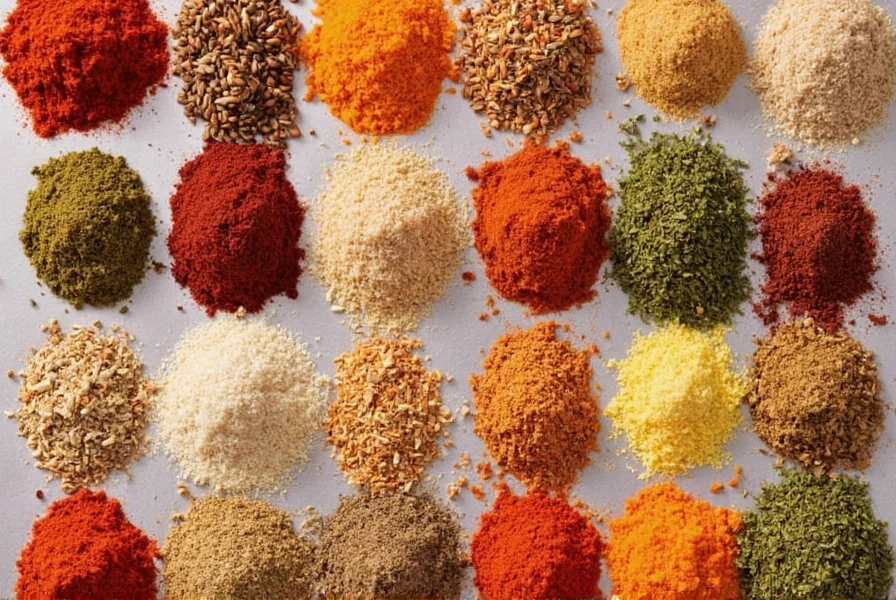
Southeast Asian (Thailand, Vietnam, Indonesia)
Southeast Asian cuisine emphasizes fresh herbs and balanced flavors, with spices used to create aromatic complexity.
- Lemongrass: Citrusy stalks essential for Thai curries and Vietnamese pho. Use the lower white part for best flavor.
- Galangal: A ginger relative with sharper, pine-like notes. Critical for Tom Yum soup and Thai curries.
- Kaffir Lime Leaves: Distinctive floral aroma. Tear leaves before adding to release oils in curries and soups.
- Star Anise: Licorice-flavored pod used in Vietnamese pho and Chinese five-spice powder.
Middle Eastern (Lebanon, Iran, Israel)
Middle Eastern spices focus on aromatic warmth and tangy brightness, often used in spice blends and dry rubs.
- Za'atar: Traditional blend of thyme, sumac, sesame seeds, and salt. Perfect for flatbreads and roasted vegetables.
- Baharat: "Spice mixture" in Arabic. Typically includes black pepper, cinnamon, and allspice for meat dishes.
- Sumac: Tangy, lemony berry powder. Sprinkle on hummus, grilled meats, or salads.
- Saffron: The world's most expensive spice. Used sparingly in Persian rice dishes and stews.
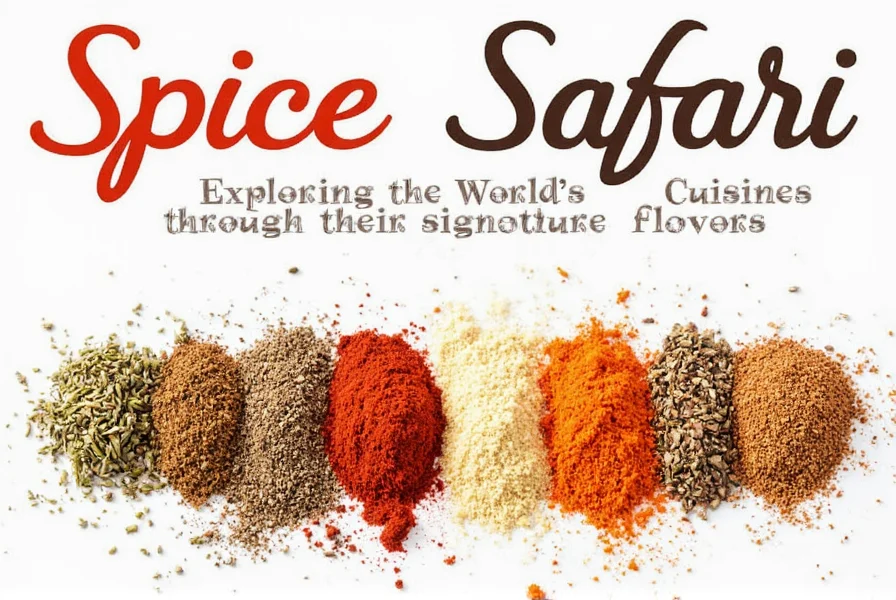
Mediterranean (Italy, Greece, Spain)
Mediterranean cooking uses fresh herbs and subtle spices to enhance natural flavors without overpowering.
- Oregano: Earthy and robust. Essential for Greek salads, tomato sauces, and roasted vegetables.
- Rosemary: Woody and fragrant. Ideal for roasted lamb, potatoes, and breads.
- Saffron: The most expensive spice globally. Used in Spanish paella and Italian risotto for golden color and floral notes.
- Pimentón (Spanish Paprika): Smoked paprika adds depth to chorizo, seafood, and stews.
Latin American (Mexico, Peru, Brazil)
Latin American cuisine combines indigenous and colonial influences with vibrant, spicy flavors.
- Ancho Chili: Mild, sweet dried chili. Essential for mole sauces and enchiladas.
- Chipotle: Smoked jalapeño. Adds heat and smokiness to salsas and marinades.
- Annatto: Natural red dye from seeds. Used in cochinita pibil and rice dishes.
- Epazote: Unique herbal flavor. Traditional in Mexican bean dishes for digestive benefits.
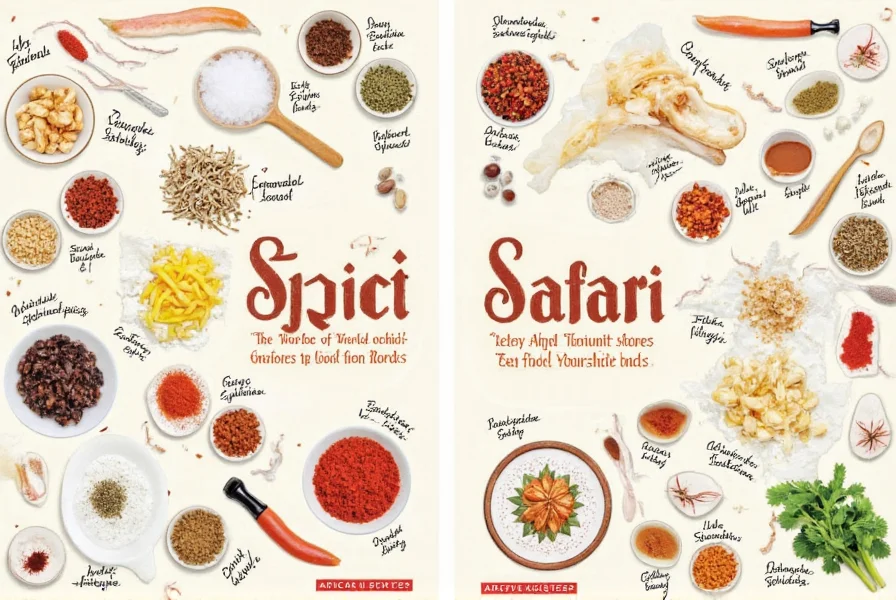
Practical Spice Usage Techniques
Whole vs. Ground Spices
| Type | Best For | Storage Tips |
|---|---|---|
| Whole Spices | Longer shelf life (3-4 years) | Store in airtight containers away from light |
| Ground Spices | Convenience, immediate flavor release | Replace every 6-12 months for peak freshness |
Always toast whole spices before grinding to unlock their full aroma. For example, dry-toast cumin seeds for 2 minutes before using in Indian or Mexican dishes.
Protein-Specific Spice Pairings
| Protein | Best Spice Pairings | Traditional Dishes |
|---|---|---|
| Chicken | Paprika, cumin, thyme, turmeric | Moroccan tagine, Indian butter chicken |
| Lamb | Rosemary, coriander, mint, sumac | Greek souvlaki, Middle Eastern kofta |
| Beef | Black pepper, chili, cumin, smoked paprika | Argentinian chimichurri, Mexican carne asada |
| Seafood | Dill, saffron, lemon zest, fennel | Spanish paella, Thai fish curry |
| Tofu | Curry powder, turmeric, ginger, garlic | Indian paneer substitutes, Thai stir-fries |
Heat Control Techniques
For spicy dishes:
- Add heat early for integrated flavor (e.g., chili powder in sauce base)
- Add fresh chilies at the end for bright heat (e.g., Thai bird's eye chilies in stir-fries)
- Balance heat with dairy (yogurt, coconut milk) or acid (lime juice)
Spice Storage & Freshness Guide
- Airtight Containers: Glass jars with tight seals protect from moisture and light
- Storage Location: Cool, dark pantry away from stovetops and ovens
- Labeling: Include purchase date to track freshness (ground spices last 6-12 months)
- Testing Freshness: Rub between fingers - if aroma is weak, replace
- Grinding: Use a dedicated spice grinder for whole spices to maximize flavor
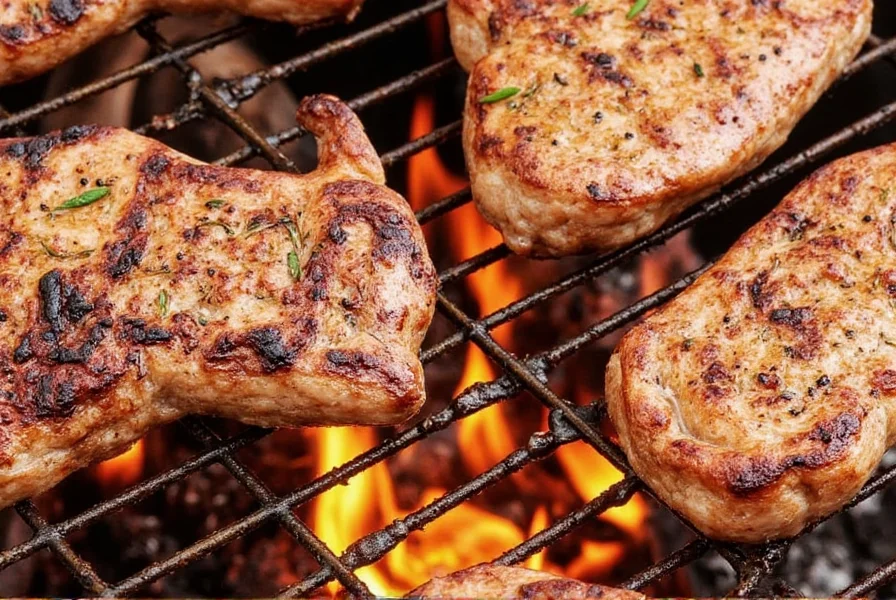
Essential Spices Buying Guide
Universal Staples for Every Kitchen
- Cumin: Earthy and smoky. Choose seeds for longer shelf life, grind as needed
- Paprika: Sweet or smoked. Hungarian varieties offer superior flavor
- Garlic Powder: Use in place of fresh garlic for consistent flavor in sauces
- Cinnamon: Ceylon cinnamon ("true cinnamon") has sweeter, more complex flavor
- Black Pepper: Always use freshly cracked pepper for maximum aroma
Cuisine-Specific Must-Haves
- Indian: Turmeric (for color and health benefits), garam masala (blend of 6-12 spices), asafoetida (for digestion)
- Thai: Lemongrass (fresh or dried), galangal (frozen works well), kaffir lime leaves (dried or frozen)
- Mexican: Ancho chili (mild), chipotle (smoky heat), epazote (for bean dishes)
- Middle Eastern: Za'atar (thyme-sumac blend), sumac (tangy red powder), baharat (warming spice mix)
- Mediterranean: Saffron (for paella), oregano (Greek variety), rosemary (fresh or dried)
Recommended Products
| Product | Description | Best Use | Quality Indicator |
|---|---|---|---|
| McCormick Culinary Ground Cumin | Consistent flavor, widely available | Curries, tacos, chili | Check for vibrant color and strong aroma |
| La Flor Guajillo Chili Powder | Mild heat, deep red color | Enchiladas, moles | Should smell fruity, not musty |
| Simply Organic Garam Masala | Balanced blend of 8 spices | Indian curries, lentils | Should have warm, sweet aroma |
| SunBrand Za'atar Seasoning | Traditional Middle Eastern blend | Dips, flatbreads, roasted veggies | Check for visible sesame seeds and thyme |
| Royal Saffron Threads | High-grade threads for premium flavor | Paella, bouillabaisse, desserts | Threads should be deep red with orange tips |
Frequently Asked Questions
How do I identify which spices define a specific cuisine?
Each cuisine has signature spice combinations based on historical trade routes and local ingredients. Indian cooking relies on turmeric, cumin, and garam masala for layered complexity. Thai cuisine balances lemongrass, galangal, and kaffir lime for aromatic freshness. Mexican dishes feature chili powders and cumin for heat and depth. Middle Eastern cooking uses za'atar and sumac for tangy brightness. Mediterranean cuisine emphasizes oregano and rosemary for herbal notes. The key is understanding how these spices interact with regional ingredients and cooking techniques.
Can I substitute fresh spices for dried in traditional recipes?
Yes, but with adjustments. Use three times the amount of fresh herbs compared to dried (1 tablespoon fresh = 1 teaspoon dried). Fresh spices like ginger or lemongrass provide brighter flavors but cook faster. For authentic results in dishes like Thai curry or Indian dal, follow traditional preparations since texture and flavor release differ significantly between fresh and dried forms. When substituting, always adjust cooking times to prevent overcooking fresh ingredients.
Why does my curry lack depth compared to restaurant versions?
Restaurant curries often toast whole spices before grinding them fresh. Try dry-toasting cumin, coriander, and mustard seeds until fragrant before adding to your dish. Layering spices at different cooking stages matters too - add ground spices early for base flavor, but finish with fresh cilantro or garam masala. Using oil properly (tempering spices in hot oil) also unlocks essential oils that create depth. For Indian curries, sautéing onions until golden before adding spices creates a flavor foundation.
How long do spices actually stay fresh?
Whole spices retain potency for 3-4 years when stored properly, while ground spices last 1-2 years. Signs of staleness include faded color, weak aroma, and flat taste. Test freshness by rubbing between fingers - if the scent is faint, it's time to replace. Keep spices away from heat sources and sunlight in airtight containers. For maximum flavor, buy whole spices and grind small batches as needed. Spices like saffron and vanilla beans require special storage in dark, cool places.
Which spices work across multiple cuisines?
Cumin appears in Indian, Mexican, and Middle Eastern dishes. Paprika bridges Mediterranean and Latin American cuisines. Cinnamon features in both Moroccan tagines and Mexican mole. Coriander seeds are essential in Indian curries and Middle Eastern rice dishes. These versatile spices create culinary bridges - use cumin for earthiness in tacos or curries, or smoked paprika to add depth to paella and chili alike. Start with these universal spices before exploring region-specific varieties.
Master Global Flavors with the Right Spices
Understanding spice profiles transforms cooking from routine to extraordinary. Whether you're making authentic Thai curry, Mexican mole, or Mediterranean paella, the right spices create cultural authenticity and unforgettable flavors.
Start with universal staples like cumin and paprika, then explore region-specific varieties. Proper storage and fresh grinding maximize flavor impact. With this guide, your kitchen becomes a passport to global cuisine.










 浙公网安备
33010002000092号
浙公网安备
33010002000092号 浙B2-20120091-4
浙B2-20120091-4